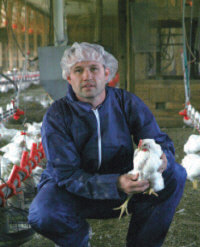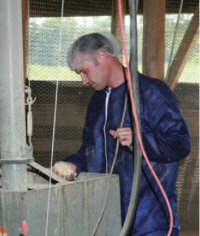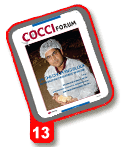Don't Mess With Vaccine Cycling
Georgia producer learns a hard but valuable lesson about managing coccidiosis effectively in broiler breeders
For decades, poultry producers
have used Coccivac-D live coccidiosis
vaccine to manage coccidiosis
in broiler breeders.
Sometimes, however, old practices
that used to work well - such as medicating
vaccinated pullet flocks with
amprolium to "take the edge off" the
vaccine's reaction - can lead to unexpected
problems. And that can be especially true if amprolium is inappropriately
paired with modern-day management
and vaccination techniques
for breeders.
As Chad Mason and his colleagues
at Columbia Farms, Lavonia, Georgia,
found out recently, such problems can
be costly.
Luckily, there's a happy ending to
Columbia Farms' story, though - one
that's allowing the northeastern
Georgia operation to improve costs and
save a substantial amount of money
per flock.
Breaking old habits

Columbia Farms is a medium-sized
diversified poultry operation that
processes about 860,000 broilers each
week. They place about 375,000 pullets
annually and keep about 270,000 hens
in the field. Mason, a Clemson graduate
and a 15-year poultry industry veteran,
is breeder and hatchery manager at
Columbia Farms.
Problems at Columbia Farms began
about 3.5 years ago and eventually
spread to four of the company's seven
pullet farms. Columbia Farms was
growing Ross 708s, which they
received from their primary breeder
pre-vaccinated with Coccivac-D, a live
vaccine formulated to accommodate
the longer life span of broiler breeders
and layers. Coccivac-D is administered
to day-old chicks in the hatchery with
a specially designed spray cabinet.
Following a time-honored practice,
Columbia Farms had been administering
amprolium, diluted 10 ounces per
gallon of water, on days 11 and 12. The
amprolium treatment was intended to
head off any problems that might
appear.
Battling blackhead and tenella
"We began to have difficulties with
blackhead (histomoniasis) and Eimeria
tenella [a leading cause of coccidiosis]."
says Mason. "I'm not sure if it was the
blackhead causing the E. tenella or the
E. tenella causing the blackhead, but we
were definitely having problems."
He was seeing livability percentages
- normally in the mid-to-high 90%
range - slip downward. Uniformity of
his birds was also suffering, plunging to
50% to 60%.
Mason explains that when E. tenella
and blackhead are ravishing a flock,
they do more than kill birds. They also
disrupt the growth and maturation of
the birds that survive.
"That means that some of the breeders
are late coming into production and
some are early," he says. "And you
can't fix that."
In other words, continuing to feed
helps the smaller birds grow faster but
keeps the larger birds growing faster,
too. "When the larger birds come into
production that fast, you can't maintain
them because you're not feeding them
enough," he explains. "Then the smaller
birds come in late, so your overall
peak isn't going to be nearly as high as
it should be. The bottom line is you're
losing money."
Struggling to gain a footing, Mason
doubled the dose of amprolium to 20
ounces/gallon. But that only made
things worse. Livability fell to 91.53% in
one of the farms - a new low - and
uniformity dropped to 40%-50%.
Mason knew he needed to take action
quickly.
Disruption in vaccine cycling

Mason contacted the technical services
group of Schering-Plough Animal
Health, makers of Coccivac-D, to discuss
the problem. He thought that perhaps
the problems might somehow be
related to the vaccine. It didn't take
long for Schering-Plough's veterinarians
to identify the problem.
"One of the problems Columbia
Farms was having - one that we've
seen pretty often at other operations -
had to do with inappropriately timed
use of anticoccidials, which can disrupt
the natural cycling of vaccinal oocysts
in vaccinated birds," says Dr. Matilde
Alfonso, one of the Schering-Plough
veterinarians involved with the discussions.
Alfonso explains that when coccidiosis
vaccines were first used back in
the 1950s and 60s, they were administered
in the drinking water and so
application of the vaccine wasn't
always completely uniform. That sometimes
led to reactions in vaccinated
flocks, and amprolium was routinely
administered prophylactically to deal
with such reactions.
"Since then, though, techniques for
administering the coccidiosis vaccine
have improved a lot," she says.
While the vaccine can still be added
to feed, most operations now opt for a
newer application method - using the
specially designed SprayCox spray cabinet
to administer the vaccine to dayold
birds as they move through the
hatchery.
The cabinet showers the birds with
live coccidial oocysts, which stimulate
the bird's immune system to build lifetime
protection against coccidiosis. A
red dye in the vaccine helps hatchery
workers monitor vaccine coverage but
it also encourages preening among
chicks - a process that helps to spread
the vaccinal oocysts to all birds.
Latest in vaccine administration

The latest method of vaccine administration
involves a further refinement in
the SprayCox cabinet. The SprayCox II
is now fitted with 2 nozzles, which
have been positioned to deliver uniform
vaccine coverage without any
wasted over-spray. A new AirMix system
also provides improved suspension
of vaccinal oocysts in the sprayer, and
that, too, helps ensure better coverage.
"The result of those refinements in
vaccine coverage is that routine follow Alfonso: 'Amprolium is no longer
necessary'up of vaccination with amprolium is no
longer necessary," Alfonso says. "In
fact, it can be detrimental to the whole
vaccine strategy."
When Coccivac-D is administered to
chicks via the spray cabinet, it delivers
a uniform and carefully balanced dose
of oocysts from the eight species of
Eimeria that are known to cause coccidiosis
in chickens. Within days of the
vaccine's administration, a new generation
of oocysts develops in the vaccinated
birds and those oocysts are then
excreted into the litter, allowing reexposure
of the birds to the Eimeria
oocysts. This helps trigger natural,
long-lasting immunity to coccidiosis.
The process usually takes about 2 to 5
cycles of re-ingested oocysts for birds
to develop full immunity to all Eimeria
species in the vaccine.
When an anticoccidial such as
amprolium is routinely added to this
finely tuned process - especially added
too early or in high dosage - it kills
the vaccine-supplied oocysts and thus
disrupts their natural cycling. The
results can be devastating, such as was
the case at Columbia Farms.
Says Mason, "Looking back on it, I
think we were knocking down the
oocysts that were cycling from the vaccine,
and that just threw everything out
of whack. We were having blackhead
problems at 5 weeks. And on top of the
blackhead, we were having outbreaks
of E. tenella."
Mason is reluctant to put an exact
dollar figure on what the coccidiosis and
blackhead episodes were costing him.
He says the losses were substantial.
But, as mentioned earlier, this story
has a happy ending.
First, Mason began a dialogue with
Schering-Plough's worldwide technical
service director, Charlie Broussard and,
working along with Alfonso and other
tech service consultants from the company,
Mason put a new plan into
motion.
Check birds before giving amprolium
To start off, Mason pulled amprolium
from the water on days 11 and 12, but
continued with his vaccination program.
He then monitored his birds
closely.
"We suggested he go out to his
houses on the 16th or 17th day and
take a close look at the birds," Alfonso
says. "Look at their overall appearance,
look at their droppings, review their
mortality figures, and, if he felt the
need, do some postings."
Mason followed that advice. Once
the vaccine was the only coccidiosis
control strategy on board, "that's when
we started seeing what we were supposed
to be seeing. We saw a little irritation
in the gut, that sort of thing, and
that showed us that the vaccine was
helping the birds develop immunity
just as it's supposed to do," Mason says.
There were other more tangible
indications that the vaccine was working.
Livability figures began edging
back up into the mid-to-high 90s - and
have stayed there. "We have improved,
from down near 91% in some of the
barns with the biggest problems, up to
better than 97% in some cases," Mason
reports.
Other results were equally dramatic.
"We saved a lot of money on not
having to buy the amprolium," he says.
"It was costing us about $400 for each
flock." They have also cut down on
antibiotics used to control secondary
infections.
Gains in uniformity, egg production
Uniformity has also improved significantly,
he says, up 15% to 20% over the
past 6 months.
Egg production has also increased.
"The latest flock we have, from one of
our problem farms, is doing real well,"
Mason says. "The way things are right
now, it's as fine a flock of chickens as
this grower has ever had."
Accounting for all production costs,
Mason says Columbia Farms has
improved cost greatly since the
changes were made.
But he is quick to point out that
besides pulling the amprolium, some
other adjustments were made in the
program.
"One of the farms we'd had trouble
in was cold-house brooding their birds
(not using air heaters)," he says. "In
other words, we had brooders only. We
were running about 700 birds per
brooder, which is too many. When
you've packed them in one spot like
that, what happens? They're going to
peck more in that one spot and that's
where the oocysts are. So we fixed
that." Mason says they have now cut
back density to 400 to 500 birds per
brooder and it has made a noticeable
difference in production. "Proper
brooding is critical," he adds.
Mason also says he now releases the
birds to full house before 14 days of
age, and that he feels that helps
achieve uniform oocysts shedding on
the litter.
He says he also makes sure heat
and moisture conditions in the barns
and in the litter remain within healthy
limits. "Before, we were cleaning out
after every flock," Mason explains.
"Now we're cleaning out once a year,
which was the recommendation from
the vaccine people."
Another step Mason's taking to keep
his program on track: Make sure birds
have adequate feed available and are
not pecking in the litter and ingesting
extra oocysts. "A lot of people in the
industry feed a full feed the first 2
weeks and then the third week they go
to poundage," referring to a specified
volume of feed, measured in pounds of
feed per 100 birds.
Mason says he found that when he
used that approach he couldn't maintain
consistent feed volume from farmto-
farm. The first couple of weeks
some of the farms would be feeding
more than others. And when, on the
third week, they went to the specified
amount of feed per 100 birds, some of
the birds would, in effect, be having
food taken away from them.
Maintaining adequate feed
"So now we know what they're getting
from day 1. The first week we feed
them 3.5 pounds (1.59 kg) of feed per
100 chickens. The second week we're
feeding them 5.5 pounds (2.49 kg). The
third week it's 6.4 pounds (2.90 kg),"
he says.
On that third week he goes to a
skip-a-day feeding program - double
the daily amount, then skipping feed
the next day. So the birds are getting 13
pounds (5.90 kg) per 100 birds on even
days, nothing on the odd days.
"It gives the birds more feeder
space, reduces competition, and keeps
them eating at the feeders instead of
pecking in the litter," he says. Again,
the aim is to limit the birds' excessive
ingestion of oocysts.
Still another ration-related matter
Mason has changed is that he is paying
more attention to feed texture.
"We try to make sure we do nothing
at all to irritate that bird's gut," Mason
says. "Can I say we're successful all the
time? No. It's not a perfect world. We
do sometimes have milling issues that
come up. But the majority of the time,
the mill does an excellent job of getting
our feed the way we want it."
Not just one fix

Summing up, Mason says it is clear that
what happened at Columbia Farms was
a complex situation that required action
on a number of fronts. He kept
Coccivac-D as a key part of his management
program, while fixing the
problems that were causing poor performance.
"I can't say that pulling the amprolium
fixed the whole problem," he says.
"You know, there are so many issues
that affect the livability of birds and
affect their uniformity - from feed texture,
to litter conditions, to heat, to bird
densities. But we've seen very good
improvements over the past 6 months
or so and I think it's a combination of
everything."
For Mason, the experiences of the
past couple of years underscore the
importance of individualizing his
approach to each flock of birds.
"You've got to look at each one on its
own. They're all unique, a little bit different."
Mason does emphasize that he
hasn't completely pulled amprolium
from his barns. He just doesn't use it
routinely, during early vaccine cycling.
"There's definitely a place for it, but
now when we need it we use it on
individual flocks, at low doses, and we
use it late. That way, we don't interfere
with the vaccine," he adds.
Dr. Alfonso agrees with him and
emphasizes that every breeder/grower
should expect consistent results from
Coccivac-D coccidiosis vaccine. If that's
not happening, she says, Schering-
Plough's technical service team is
standing by to help identify problems
that might be affecting the flock - and
to provide solutions.
In the meantime, Mason's quest for
perfection continues. "We're a work in
progress," he says. "We might stub our
toe next week, but it won't be because
we stopped trying."







